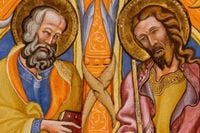On Saturday, May 3, 2025, Mexico celebrates the Day of the Holy Cross, a significant occasion that coincides with Labor Day for construction workers. This dual celebration highlights both a religious tradition and a cultural recognition of the hard work put in by laborers in the construction industry.
The Day of the Holy Cross commemorates the cross upon which Christ was crucified at Mount Golgotha in Jerusalem. According to the Catholic magazine Desde la Fe, the observance gained prominence when Saint Helena of Constantinople, mother of Emperor Constantine, embarked on a pilgrimage to the Holy Land and discovered the True Cross on May 3. Father Víctor Jiménez González, a priest, noted that the Cross of Jesus Christ is “an instrument of life,” and symbolizes the greatest proof of Christ’s love. He emphasized that it should be placed at the highest points of our homes and hearts, explaining that many ancient buildings were topped with a cross to exalt this love.
In Mexico, the Day of the Holy Cross is also celebrated as the Day of the Construction Worker, or Dia del Albañil. This tradition is rooted in the history of Saint Helena, who, after finding the cross, employed several construction workers to build the Santa Cruz de Jerusalén church, starting their work on May 3. The Catholic agency ACI Prensa highlights that this date has been celebrated for centuries in many parts of the world. Following a reform, September 14 is also recognized as the Exaltation of the Holy Cross, which commemorates the consecration anniversary of the Church of the Holy Sepulcher in Jerusalem, built after the discovery of the Cross by Saint Helena.
On this day, construction workers in Mexico typically adorn a wooden cross with flowers and place it at the top of the construction site as a symbol of protection and gratitude for their work. It's a common practice for the architect overseeing the project to host a meal in honor of the workers, often featuring traditional dishes such as carnitas, barbacoa, or carne asada. These celebrations frequently culminate in festivities that can include music and dancing, making it one of the most anticipated days of the year for these workers.
May is a month rich with celebrations in Mexico, including International Workers' Day, the Anniversary of the Battle of Puebla, and Teacher's Day, but the Day of the Holy Cross stands out as a day of joy among construction workers. Thousands of laborers are expected to celebrate at their respective job sites, showcasing their pride and dedication to their craft.
The custom of placing a cross on construction sites has deep historical roots, dating back to the 4th century when the Basilica of the Holy Sepulcher was constructed in Jerusalem. Workers faced numerous challenges during the construction, leading them to place a cross as a protective measure against evil. Over time, May 3 was established as the Day of the Holy Cross, and construction workers adopted the cross as a protective amulet, celebrating it with various rituals and festivities.
In addition to the celebration of the Day of the Holy Cross, May 3 also marks the feast day of Saints Philip and James in the Catholic Church. Saint Philip, a disciple of John the Baptist, became the first bishop of Jerusalem following Christ's ascension. He is remembered for preaching the Gospel in Greece, Syria, and Phrygia and for introducing Nathanael to Jesus, proclaiming him as the Messiah prophesied by Moses. Philip was also present at the Last Supper, where he expressed a desire to know the Father, prompting Jesus to teach about the unity of the Father and the Son.
Saint Philip and Saint James are commemorated together on this day because their relics were brought simultaneously from Hierapolis and Jerusalem to Rome in the 6th century. Both saints are martyrs; Philip was crucified upside down in Hierapolis, while James is believed to have died by stoning between 62 and 66 AD. The Catholic Church honors their contributions to the faith and their sacrifices.
Today, the Catholic Church celebrates not only the Day of the Holy Cross but also the lives of other saints such as Saint Timothy, Saint Maura of Antinoe, and Blessed Emilia Bicchieri, among others. Each of these figures has left a lasting impact on the Christian community, serving as examples of faith and virtue.
As the Day of the Holy Cross and the Day of the Construction Worker unfold, it serves as a reminder of the intertwining of faith, culture, and labor in Mexico. The celebration is not just about honoring the cross but also recognizing the hard work and dedication of the millions of construction workers who contribute to building the nation. With over 1.6 million people engaged in construction-related work in Mexico, according to the Ministry of Economy, this day stands as a testament to their importance in society.
In summary, May 3, 2025, encapsulates a rich tapestry of traditions and celebrations in Mexico, blending the sacred with the secular. The Day of the Holy Cross, coinciding with Labor Day for construction workers, highlights the significance of faith in everyday life, while also honoring those who labor diligently to build and shape the country's infrastructure. As workers gather to celebrate, they not only pay homage to their craft but also to the deep-rooted traditions that have shaped their identities.


